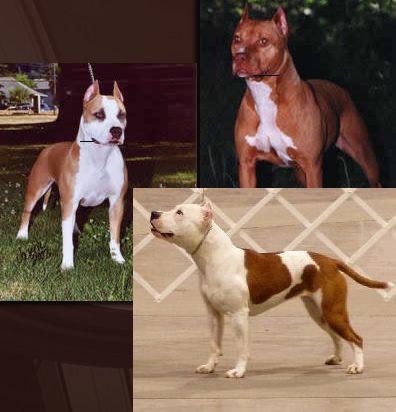Forequarters!
NECK - Neck is of moderate length and muscular. There is a slight arch at the crest. |
 |
| Well laid-back shoulders |
3 lovely necks with excellent arches. Very graceful and beautiful |
| IMPORTANCE OF A NECK!!! |
| A UKC Judge and APBT Breeder notes with dismay that he is seeing a predominance of APBTs in the show ring with thick short necks and judges that are putting these dogs up consistently. Also of concern are very thin necks which are not as prevalent but of equal significance as a fault. A short stubby thick neck is a FAULT!!!!!! The neck should DEFINITELY have more length than the dogs skull and should have a shape that tapers from the shoulders to where it joins with the head. BULL NECKS are not optimal, nor moderate, nor functional in a all around working breed. |
| JUDGING LENGTH OF NECK. |
| Length of neck. When stacked, draw a line from the lower jaw parallel to the ground along the dogs back. This line should be well above the dogs back if the dog has a proper length of neck. If this line runs right along the top of the back then the neck is much too short. |
3 dogs with short necks that are too thick |
| The neck widens gradually from where it joins the skull to where it blends into well laid-back shoulders. The skin on the neck is tight and without dewlap. |
| Faults: Neck too short and thick; thin or weak neck; ewe neck; dewlap see faults page |
 |
| FIGURE 11- this indicates a properly arched neck. Notice that the lower jaw is parallel to the ground and the arch is not artificially created by baiting the head down. Also note the wedge shape of the skull seen from the side. This is a gorgeous neck! |
Shoulders The shoulder blades (scapula) are long, wide, muscular, and well laid back. The upper arm (humerus) is roughly equal in length to the shoulder blade (scapula) and joins it at an apparent right angle. |
| A UKC Judge and breeder notes that it is becoming common to see dogs with significantly shortened upper arms. This gives the dogs top line a "hot rod" or "high in the rear" look when moving. The dog may even move correctly but this is a serious problem that is occurring in the breed. |
 |
This dog has wonderful layback. This is well-laid back. This dog has a functional layback of almost 42 degrees. The lines passing through the shoulder indicate a perfect 45 but this is not quite the case. Also notice the 90 degree angle formed by the humerus and the scapula (the shoulder and the upper arm) |
| The above graphic shows how angulation is estimated at the shoulder including a "well laid back 45 degree" set to the shoulder blade and the 90 degree angle between the shoulder blade and upper arm. Optimally the APBT should have a little less that 45 degree layback probably around 42 degrees. |
The forelegs are strong and muscular. The elbows are set close to the body. Viewed from the front, the forelegs are set moderately wide apart and perpendicular to the ground (FIGURE below). |
This figure gives an indication of what legs being perpendicular to the ground along with elbows that are tight against the body refers to, and shows a graphic in blue lines portraying what legs that are out at the elbows would mean and how this creates something that is not perpendicular to the ground. |
| The pasterns are short, powerful, straight, and flexible. When viewed in profile, the pasterns are nearly erect (see pictures above for profile of pasterns). |
 |
| Above is a small study on pasterns. Note that nearly erect, short and flexible in order to exist simultaneously must by necessity conform to moderate and flexible. There are 3 pasterns shown above which will breakdown quickly on a working dog. These are the 3 upright pasterns. The moderate flexible pasterns shown provide a good general ideal. The nice length flexible pasterns fulfill the ideals of a true working breed that needs agility and flexibility. Finally the short flexible pasterns also provide good moderation. |
Faults:
(see faults page for photos of these faults) |
To Learn more about related structure after visiting this page visit the following pages |






